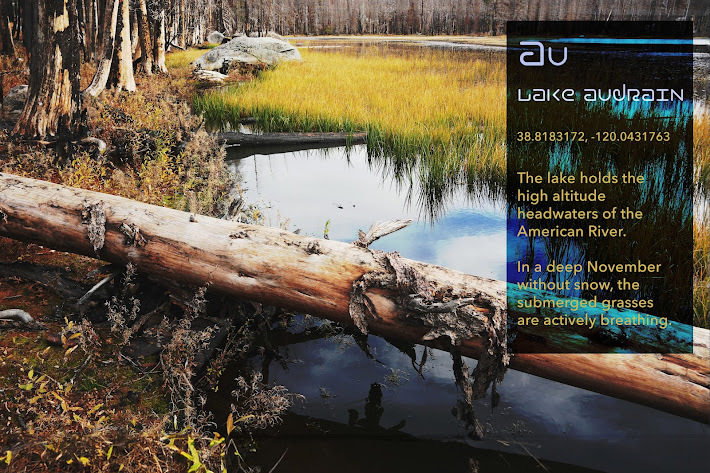RIPE AREA is a play on the term "riparia", the land adjacent to and influenced by water.
The waters of the South Fork of American River tumble downstream in the crush of ice melt, rushing in currents, propelled by dam releases, and slowing along sandy flatlands. Wet, fluid fingers fan out among cattails, quietly seeping into sodden ground.
Headwaters of the South Fork of the American River collect in high-altitude Lake Audrain, captured in the image I created, above, for the music and underwater sound art installation, Music for 33 Drain Pipes, by Paul Godwin, experienced as a walk along Wakamatsu Pond during the RIPE AREA Arts & Nature Festival on June 2nd, 2024. The installation offered seven stations for listeners to experience to different parts of the watershed of the American and Cosumnes Rivers. By using technology that allows us to put our ears underwater, we hear the workings of photosynthesis, decomposition, and living species in ponds, creeks, lakes, and rivers.
To experience the piece, listeners need to slow down and tune into the sounds made by underwater plants breathing.
As humans have invented technologies and designed infrastructures to control fresh waters and undo their natural flows, at the same time, we lost touch with much of the wisdom that still surrounds the river and its living environment--the wisdom of its original caretakers, Native Peoples, Salmon, Beaver, Elderberry, and Acorn, to name a few.
Our work as Myrtle Tree Arts, in partnership with American River Conservancy, is about renewing relationships with nature through emotional and spiritual connections, scientific study, conservation, stewardship, and restoration work that everyone can contribute to. Our projects that integrate art and science also aim to elevate Native wisdom and practice, native plants and foods, and native species that are keepers of the ecosystem. We want people to feel our interdependence with them and with this vital watershed.
Harnessing the arts, RIPE AREA is a multiplicity of songs, stories, sounds, tastes, movements, and images created by many contributors who are inspired by the rivers and riparian habitat. Our artistic streams created and shared in collaborative workshops during the last year, and culminating in a community festival, are merging together as raw material for renewing our relationships with natural systems.
—Ameera Godwin, Artistic Director and Co-Creator, RIPE AREA, 2024
Images by Ameera Godwin: Lake Audrain and Slab Creek for Music for 33 Drain Pipes, by Paul Godwin
RIPE AREA Arts & Nature Festival
Inspired by Water and Riparian Habitat
EXPLORE, MAKE, TASTE, LEARN & PLAY
Live Music - Native Food & Plants - Kids Zone - Eco Talks
When: Sunday, June 2nd, 11:00 AM - 6:00 PM
Where: Wakamatsu Farm, 941 Cold Springs Road, Placerville
See the full FESTIVAL PROGRAM HERE.


Comments
Post a Comment